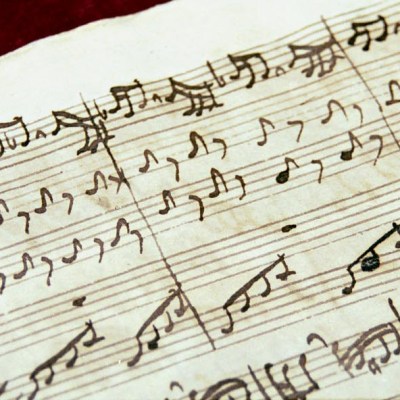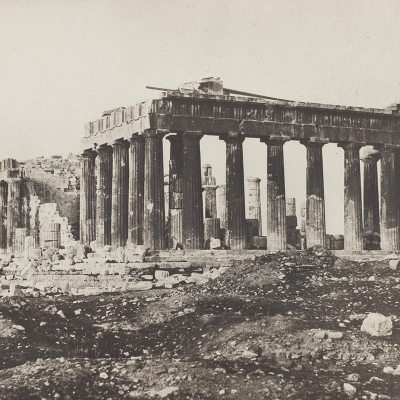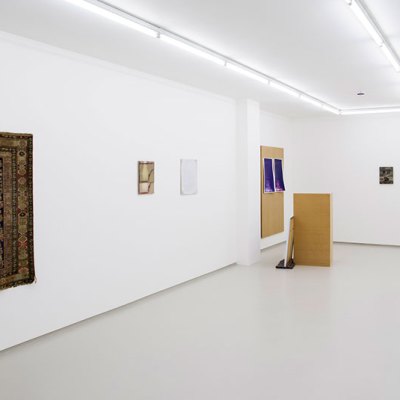In March, Pallant House Gallery opens an exhibition dedicated to Leon Underwood, an influential but largely overlooked figure in the history of British art. Simon Martin tells us more about the artist and his legacy.
Click here for a gallery of highlights from the exhibition
Can you tell us a bit about the exhibition?
The exhibition, ‘Leon Underwood: Figure and Rhythm’, presents a long-overdue retrospective of the artist who has been described as ‘the precursor of modern sculpture in Britain’. Leon Underwood (1890–1975) was a radical influence on some of the most important modern British artists who were his students, including Barbara Hepworth, Henry Moore and Eileen Agar, but has not received the recognition he so clearly deserves.
Self-portrait in a Landscape (1921), Leon Underwood. Private collection © The Estate of Leon Underwood

Although he is perhaps best known as a sculptor, the exhibition seeks to present Underwood’s creativity in the round, including paintings, drawings and prints, from a War Art Commission based on his experiences as a camouflage artist in the First World War through to his late bronzes of the 1960s on philosophical themes. But whilst other artists veered towards abstraction in the 1920s and ‘30s, Underwood’s work was always rooted in the human figure. His approach to life-drawing was revolutionary because his free and expressive approach broke with the academic tradition of art schools. As a printmaker he became the focus for what is known as the ‘Underwood School of Wood Engraving’ which encompasses his students at his Brook Green School, such as Gertrude Hermes and Blair Hughes-Stanton. Whilst in New York in the late 1920s Underwood was also a significant figure in wood-engraved book illustration.
Underwood was also an early and avid collector of non-Western art, particularly African, Mayan and Aztec carvings. The show seeks to demonstrate how it inspired the rhythmic forms of his art, and how his trips to Mexico (in 1928) and across West Africa (1945) inspired the subject matter of his work, introducing a truly international influence into modern British art that went beyond purely formal concerns.
What makes this a distinctive show?
This is the first museum retrospective of Leon Underwood’s work for over 45 years. For many visitors his oeuvre will be unfamiliar, and hopefully surprising. It is fascinating how influential figures can seem to ‘disappear’ from the canon of art history; this show seeks to reconsider his position. Over 40 years ago Sir John Rothenstein, a former director of the Tate, said that the time was overdue for a major exhibition of his work; finally, this is it.
As well as being an opportunity to reappraise Underwood in terms of modern British sculpture, it should tell us more about the impact of non-Western art in the 1920s and ‘30s. But it is also the first exhibition ever to present a comprehensive overview of Underwood’s output as a printmaker, and many of his rare etchings, wood-engravings and linocuts are brought together for it. In addition to my contribution as curator, the catalogue features texts by Adrian Locke from the Royal Academy on Underwood’s travels in Mexico; the art historian Charlotte Stokes on the Brook Green School and Underwood as anthropologist; and an essay by Ben Whitworth, who was the author of the catalogue raisonée.
How did you come to curate this exhibition?
A couple of years ago I visited one of Underwood’s relations, and was fascinated to encounter so many works that I had never seen before. I was struck by how such an interesting artist could have fallen from view. A few of his sculptures in the extraordinary Frost Evill collection sale at Sotheby’s created new records in 2011, and his work was featured in major surveys at the Royal Academy such as Penelope Curtis’ ‘Modern British Sculpture’ and Adrian Locke’s ‘Mexico: A Revolution in Art’, which confirmed for me that the time was right for Underwood to receive a closer look. I then set out on a mission to bring together as many of his significant works as possible for the exhibition and accompanying book. The existence of Ben Whitworth’s catalogue raisonée of Underwood’s sculptures helped my search, as did the assistance of the artist’s various grandchildren, and several enthusiastic lenders, one of the most surprising of whom is Jeffrey Archer, who proudly shows Underwood’s extraordinary Venus in Kensington Gardens alongside his Impressionist collection in his London penthouse.
What is likely to be the highlight?
In such an exhibition I think it is hard to pick out a single work, although Underwood’s small but arresting early etching Self Portrait in a Landscape seems to intrigue everyone. I am personally struck by Underwood’s Carrara marble sculpture Nucleus (c.1923), a three-dimensional response to Cubist painting, the forms of tribal art, and developments in science that is also a remarkable manifestation of ‘direct carving’ in the early 1920s. It is like nothing else in modern British art. Underwood was at once interested in ‘primitivism’ as a mode of expression, but utterly forward-thinking.
And what’s been the most exciting personal discovery for you?
I have been privileged to be able to look through previously unexhibited material that is still in the artist’s family, and I was delighted to discover a 1924 preparatory drawing for an alabaster carving, and notice that it also held studies for an early linocut, demonstrating how Underwood was thinking about the figure in the same way across different media. It is perhaps rather nerdish, but very rewarding for me as an art historian. I was also delighted to find Underwood’s first self-portrait etching created just after he left the Royal College of Art in 1913, and as far as I know, never previously published.
What’s the greatest challenge you’ve faced in preparing this exhibition?
Locating particular artworks by an artist whose work has not frequently appeared at auction comes with its own difficulties. I will often use auction sales listings or places like the Witt Library to trace works, but in this case I have come up across quite a few dead-ends. No doubt I will now be contacted by collectors who have had his paintings in their family since the 1920s. Trying to create definitive lists of Underwood’s print oeuvre has also been rather complicated as the artist would sometimes give the same work different titles, or different works the same title.
The Skylight (The Studio) (1925), Leon Underwood. Private collection © The Estate of Leon Underwood

In my Museum Director hat, fundraising for an exhibition of an artist who is by no means a household name poses its own challenges, and requires much persuasion. But I passionately believe that these kinds of exhibitions that reassess artists are important. Perhaps we have developed a niche for this at Pallant House Gallery – following on from exhibitions of artists such as Edward Burra, Robin Ironside, John Tunnard, and the recent ‘British Artists and the Spanish Civil War’ which presented the work of numerous little-known artists alongside the likes of Picasso and Moore.
How are you using the gallery space? What challenges will the installation pose?
One of the greatest technical and aesthetic challenges is creating a coherent and meaningful presentation of an artistic output that is so multidisciplinary: not just sculptures in a variety of media – stone, wood and bronze – but also oil paintings, drawings and prints in a range of different techniques. The show includes around 40 sculptures and maquettes, and so for a relatively compact museum ensuring that each has an appropriate plinth or case has been quite a logistical enterprise. Hopefully the visual dialogue between artworks will be engaging and rewarding to the eye.
Alongside we have two complementary displays: ‘Wood Engraving and the Brook Green School’ which presents some of the prints by Underwood’s students including Eileen Agar, Gertrude Hermes, Blair Hughes-Stanton and Henry Moore, and in the De’Longhi Print Room, ‘Joseph Emberton: The Architecture of Display’, an exhibition focusing on the modern architecture of Underwood’s lifelong friend, whose daughter married his son. These enable us to reflect on wider spheres of influence in modern art and design.
Which other works would you have liked to have included?
I was very sad that Tate were unable to lend Underwood’s important 1920s wood carving Totem to the Artist as it is part of their ‘Walk Through British Art’ displays – but on the other hand it is a good thing that it is currently on show at Tate Britain. It can be frustrating when you are organising a retrospective of an underexposed artist, and a museum turns down a request and the work remains in storage unseen by the public for perhaps another 40 years. But for me the most significant absence is Underwood’s remarkable 1935 African Madonna (or ‘Black Virgin’) which is now in St George’s Anglican Cathedral in Cape Town, South Africa. This is a carved lignum vitae sculpture reinterpreting an archetypal subject from Western art in a form inspired by indigenous Bantu carvings. It would have been wonderful to be able to present it, but sadly our budgets wouldn’t stretch to bringing that, or indeed his 1934 bronze Harlem Rhythm, which is now in a private collection in New York.
‘Leon Underwood: Figure and Rhythm’ is at Pallant House Gallery, Chichester, from 7 March–14 June.
Related Articles
Review: ‘Conscience and Conflict’ at Pallant House Gallery (Emma Crichton-Miller)




